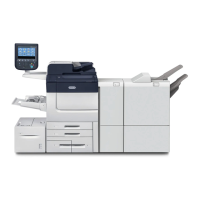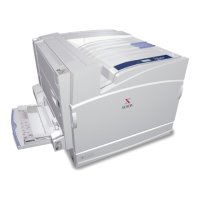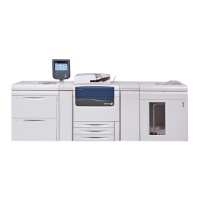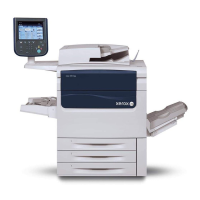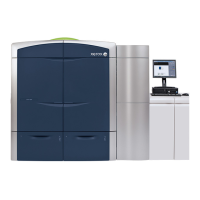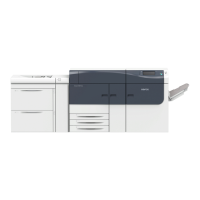What causes Xerox PrimeLink B9110 Printer copies to be too light?
- PPaul MontgomeryAug 27, 2025
If your Xerox Printer copies are consistently too light, it's likely that the copy density setting is set to Light.

What causes Xerox PrimeLink B9110 Printer copies to be too light?
If your Xerox Printer copies are consistently too light, it's likely that the copy density setting is set to Light.
Why aren't documents feeding into the document feeder of my Xerox Printer?
If documents aren't feeding into the document feeder of your Xerox Printer, it could be because the documents are too small. The minimum size of the document that can be loaded on the document feeder is A5, which is 148 x 210 mm (5.8 x 8.3 in.).
Why do I get an error message on my Xerox Printer after loading paper in Tray 5 (Bypass)?
If you're getting an error message after loading paper in Tray 5 (Bypass) and pressing the Start button on your Xerox Printer, the paper guides at the front of the tray might be incorrectly positioned. Make sure to set the paper guides to the correct positions.
Why does the printed toner smudge when rubbed on my Xerox prints?
If the printed toner smudges when rubbed on your Xerox prints, it could be due to a couple of reasons. The paper might be damp, so try replacing it with paper from a new ream. Alternatively, the paper you're using might be unsuitable; try loading suitable paper.
Why does a stripe pattern appear in copies from my Xerox Printer?
If a stripe pattern appears in copies from your Xerox Printer, the document enlargement ratio is likely set too large. Some enlargement ratios can cause stripes, so try adjusting the copy enlargement ratio.
How to fix an error message after loading paper in paper Tray 5 (Bypass) on Xerox Printer?
If you receive an error message after loading paper in paper Tray 5 (Bypass) and pressing the Start button, make sure that the paper guides at the front side of paper Tray 5 (Bypass) are set to the correct positions.
How to turn on Xerox PrimeLink B9110?
If your Xerox Printer is not powering on, there might be a few reasons. First, check if the power switch is in the off position and switch it on. Second, ensure the power cord is properly plugged into both the electrical outlet and the printer. If the power cord is disconnected, firmly plug it in and then turn the power switch on. Lastly, make sure the power supply provides the correct voltage (200-240 V, 15 A) and is compatible with the printer's maximum power consumption (2.8-3.1 KVA).
Why are black lines printed on my Xerox PrimeLink B9110 Printer copies?
If black lines are appearing on your Xerox Printer copies, the drum cartridge may be depleted or damaged, so contact Xerox Technical Customer Support. Alternatively, the document glass on the document feeder might be dirty; clean the document glass.
Why does dirt appear at equal intervals on my Xerox PrimeLink B9110?
If dirt appears at equal intervals on your Xerox Printer, there may be dirt on the paper feed path. Try printing a few pages to see if the issue resolves itself.
Why is nothing being printed on my Xerox PrimeLink B9110?
If nothing is being printed on your Xerox Printer, it could be due to a couple of reasons. Two or more sheets of paper might be feeding simultaneously (double feed); fan the paper and then reset it. Alternatively, there might be a high-voltage power supply malfunction; in this case, contact Xerox Technical Customer Support.
| Category | Printer |
|---|---|
| Print Technology | Laser |
| Print Resolution | 1200 x 2400 dpi |
| First-Print-Out Time, Printing | 4.5 seconds |
| Memory (Standard) | 8 GB |
| Hard Drive | 320 GB |
| Connectivity | USB, Ethernet, Wi-Fi |
| Scan Resolution | 600 x 600 dpi |
| Type | Multifunction |
| Paper Sizes | Letter, Legal, A4, A5 |
| PDL | PCL, PostScript, PDF |
| Network Connectivity | Ethernet, Wi-Fi |
| Operating System Compatibility | Windows, macOS, Linux |
Important safety instructions and guidelines for continued safe operation of your printer.
Guidelines for safe handling of electrical components and power cords to prevent shock or fire.
Safety guidelines for operating the printer, including handling moving parts and hot surfaces.
Information regarding laser safety standards and warnings for Class 1 Laser products.
Safety precautions related to the lithium battery used in the printer, including explosion risks.
Safety precautions for performing maintenance procedures and handling consumables.
Warnings and guidelines for handling ink, toner, and fuser fluid, and storing consumables.
Procedures for printing documents via a network using PostScript and PCL print drivers.
Covers the fundamental procedure for scanning documents, including loading and storing.
Details the tabs and options available for scan methods like Network Scanning and Email.
Steps for scanning a document and sending it as an email attachment.
Step-by-step guide to sending a fax using the multifunction printer's embedded fax feature.
Explanation of how to save and access frequently used features and job settings.
Step-by-step guide to saving feature settings and operations as a stored program.
Instructions for storing programs specifically for use with the Build Job feature.
Instructions on how to load and execute a stored program.
Allows verification of active, pending, and completed jobs, with options to cancel or print.
Provides access to device status information, including device information, faults, and supplies.
Procedures for cleaning the printer exterior, touch screen, document glass, and rollers.
Guides for checking supply status and replacing consumables like toner cartridges.
Table of common symptoms, checks, and remedies for printer issues.
Solutions for common image quality problems like dirty components or incorrect settings.
Guidance for resolving issues such as documents not feeding or incorrect copy size.
Solutions for problems encountered during printing, like inability to print or incorrect results.
Troubleshooting steps for issues like unable to scan or import scanned documents.
Instructions for clearing paper jams in various locations within the printer and feeders.
Solutions for issues related to sending and receiving faxes.
Explanation of fault messages, including illustrations and corrective actions.
Guidance for clearing paper jams within the High Capacity Feeder.
Guidance for troubleshooting paper skew and jam issues in the OHCF.
Guidance for clearing paper jams within the Interface Decurler Module.
Guidance for clearing paper jams that occur in the inserter module.
Guidance for clearing paper jams occurring in various areas of the High Capacity Stacker.
Guidance for clearing paper jams in the Crease and Two-Sided Trimmer.
Guidance for clearing paper jams that occur in the C/Z Folder.
Information on ordering and replacing finisher consumable supplies like staples and waste containers.
Guidance for clearing paper jams and resolving staple faults in the PR Finisher family.
Guidance for clearing paper jams and resolving fault codes for the SquareFold® Trimmer.
